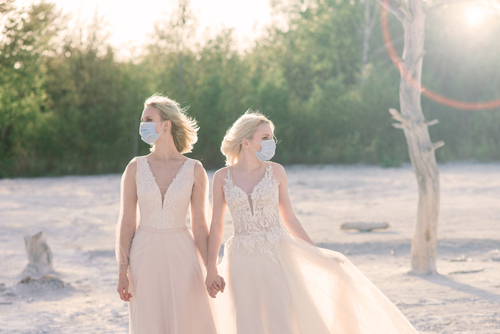Extra Wedding Safety Measures During COVID-19

COVID-19 has changed how weddings are done. Few couples host theirs without masks, hand sanitizer, and physical distancing measures. But what else are couples doing to keep themselves and their loved ones healthy? With safety a high priority, here are a few things to keep in mind as you plan your 2021 nuptials.
Wedding Safety Emails
Communication is vital when you’re planning a wedding. And keeping your guests informed is especially important in the COVID-19 age. Wedding Wire’s Kim Forrest suggests sending a wedding safety email a few weeks before your big day. Your language should be clear and concise, outlining safety precautions and other key details:
- Guest count restrictions
- Venue information, including indoor and outdoor events
- Mask wearing
- Physical distancing guidelines
- Table and seating assignments
- Food and drink service
- Dancing and entertainment
- Hand sanitizer
- Card and gift logistics
- Livestream information
Forrest includes sample verbiage that can help you as you’re crafting your email. It’s also a good idea to post the text of your email on your wedding website. Using a friendly and informative tone should get your message across. Don’t forget to stress that guests who aren’t feeling well should stay home. You can invite them to join you during your livestream.
Temperature Checks
A year ago, no one dreamed that temperature checks would be a thing at weddings. Now, it’s become de rigueur at most celebrations. Fever is a common COVID-19 symptom, so screening may identify infected people. Fevers start above 100.4 degrees Fahrenheit, so anyone running a high temperature shouldn’t be allowed inside.
Temperature checks can be useful, but Kim Forrest mentions some caveats in another Wedding Wire piece. Some people with COVID-19 are asymptomatic – they don’t display physical symptoms or even run fevers. Screening guests’ temperatures also can’t replace common safety protocols. Wearing masks, observing physical distancing, and practicing good hand hygiene are still critical. If you still want to do temperature checks, no-contact thermometers may be your best bet. Cleveland Clinic explains that they use infrared scanning to detect body temperatures. Thanks to this technology, there’s no physical contact involved.
Pre-Event COVID Testing
Couples can’t test their guests for COVID-19 at the door, but some have asked guests to get screened before their weddings. Ideally, anyone with confirmed negative results could attend and pose no risk to others. Harvard Health describes a few different tests. Viral RNA tests use nasal or throat swabs, but so do antigen tests. There are also antibody tests that can identify if you’ve had a past infection.
The major downside is that any COVID test can only tell whether you had it at the precise moment of screening. Should you contract it after the test, a negative result will do you no good. There’s also the question of availability. Some clinics and pharmacies are offering testing at no cost. KFF explains that public and private health insurance must cover testing if an attending provider deems it medically necessary. But if some guests can’t access free testing facilities or get insurance to cover the cost, they may have to pay out of pocket.
If you want to ask guests to get tested, Forrest suggests including this information near the top of your wedding safety email. Guests may want to quarantine after testing to reduce the risk of developing COVID-19.
Happy and Healthy Weddings in 2021
Weddings look far different in 2020 and 2021 than they did in 2019. Couples must factor in extra planning steps due to COVID-19, but these are vital to protecting their guests’ health. Mask wearing, hand hygiene, and physical distancing are the most important safety protocols, but other measures can add an extra layer of safety. Above all else, clear communication to guests is critical in helping slow the spread during the pandemic.














